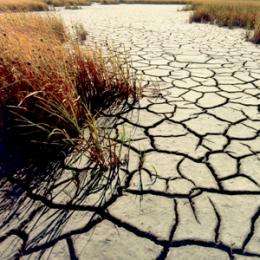Extreme summer temperatures occur more frequently: study

(PhysOrg.com) -- Extreme summer temperatures are already occurring more frequently in the United States, and will become normal by mid-century if the world continues on a business as usual schedule of emitting greenhouse gases.
By analyzing observations and results obtained from climate models, a study led by Phil Duffy of the Lawrence Livermore National Laboratory showed that previously rare high summertime (June, July and August) temperatures are already occurring more frequently in some regions of the 48 contiguous United States.
"The observed increase in the frequency of previously rare summertime-average temperatures is more consistent with the consequences of increasing greenhouse gas concentrations than with the effects of natural climate variability," said Duffy, who is the lead author of a report in a recent edition of the journal, Climatic Change. "It is extremely unlikely that the observed increase has happened through chance alone."
The geographical patterns of increases in extreme summer temperatures that appear in observations are consistent with those that are seen in climate model simulations of the 20th century, Duffy said.
Duffy and colleague Claudia Tebaldi, a senior scientist at the nonprofit news and research group Climate Central, showed that the models project that previously rare summer temperatures will occur in well more than 50 percent of summers by mid-century throughout the lower 48 states.
The team first compared the period 1975-2000 to the preceding 25 years, and found that both observations and results based on 16 global climate models show that summertime-average temperatures that were rare in the earlier period occurred more often in the later period, in certain regions. The agreement between observations and models demonstrates that the models are able to simulate changes in the occurrence of extreme summertime temperatures, Duffy said.
Duffy and Tebaldi performed a statistical analysis showing that the increases in rare summer temperatures seen in the later period are very unlikely to have occurred through chance weather variations.
Next, Duffy and Tebaldi assessed the present period, by using results obtained from climate models for 1995-2024; they found that summer temperatures that were extreme during 1950-1979 occur more often in the later time period. This supports the conclusion that extreme summertime temperatures are already occurring more frequently in parts of the lower 48 states. A second statistical analysis showed that this increase also is very unlikely to be due to chance weather variations alone, such as El Niños or La Niñas.
Finally, the team evaluated model results for 2035-2064 (representing the middle of this century) and found that extreme summertime temperatures that were rare during 1950-1979 are projected to occur in most summers throughout the 48-state region in the mid-century period. For the mid-century, summertime mean temperatures that historically occurred only 5 percent of the time are projected to occur at least 70 percent to the time everywhere in the 48 state region.
"The South, Southwest and Northeast are projected to experience the largest increases in the frequency of unusually hot summers," Duffy said. "The strong increase in extremes in the Southwest and Northeast are explained by strong historical and projected warming there. This result is based upon assuming a commonly used scenario for future emissions of carbon dioxide, the main driver of human-caused climate change.
"What was historically a one in 20-year occurrence will occur with at least a 70 percent chance every year. This work shows an example of how climate change can affect weather extremes, as well as averages."
Provided by Lawrence Livermore National Laboratory


















